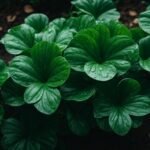Hoyas, often called wax plants, have gained immense popularity among houseplant enthusiasts, primarily for their waxy leaves and fragrant flowers. Choosing the right soil is paramount for these plants to thrive. This article delves deep into the best soil for hoyas, ensuring they remain healthy and vibrant.
Key Insights:
- Hoyas require a well-draining soil rich in nutrients.
- The soil should retain moisture but not be waterlogged.
- Peat-based soil, orchid bark mix, cactus mix, vermiculite and perlite are top choices for hoyas.
Understanding the Hoya Plant
Before diving into the soil specifics, it’s essential to understand the unique characteristics of the hoya plant. Native to Southeast Asia and Australia, these plants are epiphytes, meaning they naturally grow on other plants. This epiphytic nature influences their soil preferences, as they require excellent drainage and aeration.
Peat-Based Soil: A Top Choice
Peat-based soil stands out as an excellent choice for hoya plants. Here’s why:
- Well-draining and Aerating: Peat-based soil ensures water doesn’t stagnate, preventing root rot.
- Slightly Acidic pH: Hoyas thrive in slightly acidic conditions, and peat-based soil offers just that.
- Customizable: You can mix peat moss with perlite, vermiculite, or sand to enhance drainage.
However, it’s worth noting that peat moss isn’t sustainable. If you’re environmentally conscious, consider peat-free alternatives.
Orchid Bark Mix: Mimicking Natural Conditions
Given that hoyas are epiphytes, an orchid bark mix can be an ideal choice. This mix comprises bark, perlite, and sphagnum moss, replicating the hoyas’ natural growing conditions. The chunky nature of this mix ensures excellent drainage and aeration. However, for smaller hoya plants, this mix might be too coarse.
Cactus Mix: Another Worthy Contender
Cactus mix is another soil type that hoyas seem to love. Here’s what makes it special:
- Well-draining: Like the peat-based soil, the cactus mix ensures the roots aren’t waterlogged.
- Rich in Nutrients: This mix is nutrient-dense, ensuring your hoya gets all it needs.
- Slightly Acidic pH: Again, the slightly acidic nature of this mix is perfect for hoyas.
This mix typically consists of sand, perlite, and peat moss. It’s designed to retain just the right amount of moisture.
Vermiculite and Perlite Mix: Lightweight and Nutrient-Rich
A combination of vermiculite and perlite is another excellent soil choice for hoyas. This mix is lightweight, ensuring the roots get ample air. It’s also nutrient-rich, providing the plant with all the essentials. Mixing equal parts of vermiculite and perlite can create the perfect soil blend for hoyas.
Conclusion
Choosing the right soil for your hoya plant can make all the difference in its growth and health. Whether you opt for peat-based soil, orchid bark mix, cactus mix, or a blend of vermiculite and perlite, ensure it’s well-draining and nutrient-rich. Remember, hoyas prefer to be slightly root-bound, so choose a pot just a tad larger than the root ball. And always let the soil dry out between waterings.
Caring for Your Hoya Plant
While the soil is a significant factor in the health of your hoya plant, other elements play a crucial role, too. Let’s delve into some of these aspects:
Light Requirements
Hoyas thrive best when exposed to bright, non-direct sunlight for at least two to six hours daily. If your hoya is placed in an area with less than half a day of sunlight, it might not bloom. Ensure you position your plant in a spot where it can receive adequate light, but avoid direct sunlight as it can scorch the leaves.
Temperature and Humidity
Being tropical plants, hoyas flourish in warm and moist, humid climates. If growing your hoya indoors, consider placing it near a humidifier or regularly misting it to maintain the required humidity.
Fertilization
For a hoya plant to bloom and grow healthily, it needs nutrients. The International Hoya Association suggests feeding them with a fertilizer that includes nitrogen, phosphorus, and potassium. A monthly dose of a balanced, slow-release fertilizer should suffice.
Common Pests and Diseases
Like any other plant, hoyas are susceptible to certain pests and diseases. Sap-sucking pests like aphids, mealybugs, and spider mites can be a nuisance. These can be controlled using neem oil. If you notice any fungal infections, treat your plant with a suitable fungicide.
Encouraging Blooms
If you’re eager to see your hoya bloom, ensure it’s planted in well-draining soil, gets at least six hours of light, has moderately moist soil, and is protected against pests and diseases. Also, keeping the plant root-bound can encourage flower production.
Common Problems and Solutions
Overwatering can lead to root rot, yellowing of leaves, and drooping. Ensure the soil dries out between waterings. If your plant looks stringy, it might stretch out for more light. In such cases, move your plant closer to a light source or provide a fluorescent grow light.
FAQs
What are hoyas?
Hoyas, also known as wax plants, are tropical plants native to Asia, known for their waxy leaves and fragrant flowers.
How to care for a hoya plant?
Care for a hoya plant involves providing bright, indirect sunlight, using well-draining soil, watering moderately (letting the soil dry out between waterings), maintaining a humid environment, and feeding with a balanced fertilizer monthly.
How long is a hoya plant’s lifespan?
Hoyas can live up to 30 years indoors with proper care and by managing its environmental conditions.
Where is the best place to put a hoya?
Indoors, a northern-facing window is ideal. Ensure it gets partial sun, as full sun can be too intense.
What is a hoya plant’s growth rate?
Hoyas grow moderately, reaching maturity within three to five years on average.
Why did my hoya plant stop growing?
Several factors can halt its growth, including stress, inadequate light, or the onset of winter. Fertilizing and ensuring ample light can encourage growth.
Conclusion
Hoyas, with their waxy leaves and fragrant flowers, are a delightful addition to any home. While choosing the best soil for hoyas is crucial, other factors like light, humidity, and care practices play a significant role in their health and growth. By understanding their needs and providing the right conditions, you can enjoy the beauty of this tropical plant for years to come.
Sources / For More Information:
How to Grow and Care for Hoya Plant (thespruce.com)
A guide to the best Hoya plant soil – Plants For All Seasons
Best Hoya Soil Mix in the Hoyas forum – Garden.org


